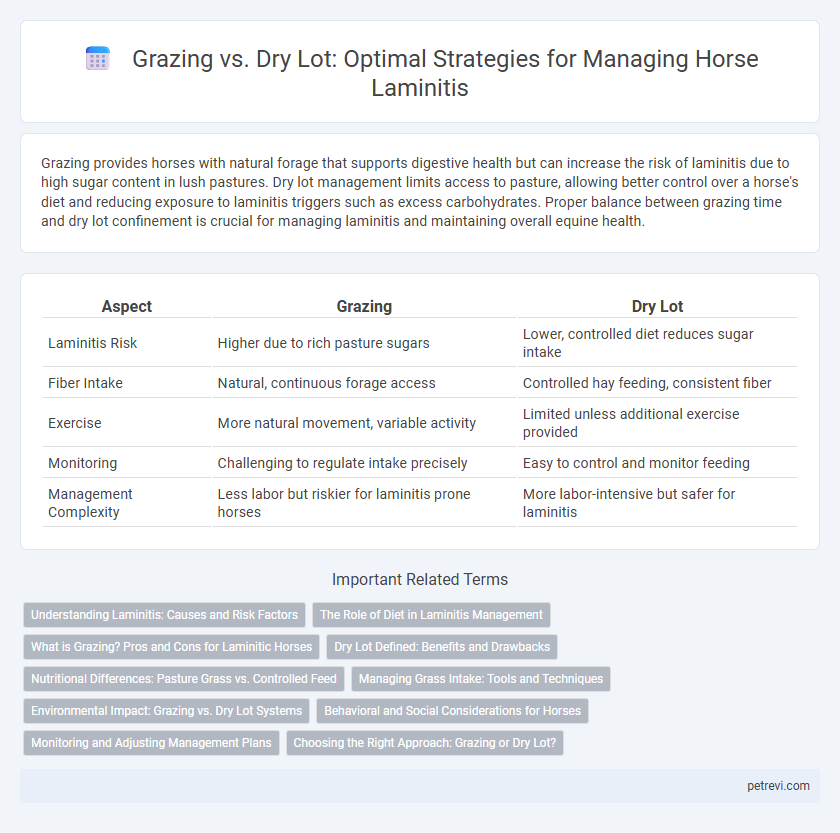Grazing provides horses with natural forage that supports digestive health but can increase the risk of laminitis due to high sugar content in lush pastures. Dry lot management limits access to pasture, allowing better control over a horse's diet and reducing exposure to laminitis triggers such as excess carbohydrates. Proper balance between grazing time and dry lot confinement is crucial for managing laminitis and maintaining overall equine health.
Table of Comparison
| Aspect | Grazing | Dry Lot |
|---|---|---|
| Laminitis Risk | Higher due to rich pasture sugars | Lower, controlled diet reduces sugar intake |
| Fiber Intake | Natural, continuous forage access | Controlled hay feeding, consistent fiber |
| Exercise | More natural movement, variable activity | Limited unless additional exercise provided |
| Monitoring | Challenging to regulate intake precisely | Easy to control and monitor feeding |
| Management Complexity | Less labor but riskier for laminitis prone horses | More labor-intensive but safer for laminitis |
Understanding Laminitis: Causes and Risk Factors
Laminitis in horses is a painful inflammatory condition affecting the laminae of the hoof, often triggered by excessive intake of non-structural carbohydrates found in lush pasture grasses. Grazing on high-sugar pastures increases the risk of laminitis due to rapid fermentation and insulin dysregulation, while dry lot management reduces access to these carbohydrates, controlling calorie intake and limiting laminitis flare-ups. Recognizing insulin resistance, obesity, and pasture-associated dietary factors as primary causes helps optimize laminitis prevention and treatment strategies in equine care.
The Role of Diet in Laminitis Management
Diet plays a critical role in managing horse laminitis, where controlled grazing limits intake of non-structural carbohydrates (NSC) that trigger inflammation. Dry lot management offers precise control over forage quantity and quality, reducing exposure to high-sugar grasses that exacerbate laminitis symptoms. Selecting low-NSC hay and supplementing with balanced nutrients supports metabolic stability essential for laminitis recovery and prevention.
What is Grazing? Pros and Cons for Laminitic Horses
Grazing involves allowing horses to feed on pasture, providing natural forage that supports their digestive health and mental well-being. For laminitic horses, grazing offers benefits such as increased movement and access to fresh air but carries risks like excessive intake of high-sugar grasses that can exacerbate laminitis symptoms. Managing grazing time and selecting low-sugar pastures are vital to minimizing laminitis flare-ups while maintaining nutritional balance.
Dry Lot Defined: Benefits and Drawbacks
Dry lot management for horse laminitis involves restricting pasture access to limit sugar intake, thereby reducing the risk of exacerbating laminitis symptoms. Benefits include controlled diet, minimized ingestion of harmful non-structural carbohydrates (NSCs), and easier monitoring of the horse's condition. Drawbacks encompass limited exercise opportunities, potential behavioral stress from confinement, and increased need for manual forage provision to maintain fiber intake.
Nutritional Differences: Pasture Grass vs. Controlled Feed
Pasture grass provides natural nutrients but varies in sugar content, often increasing laminitis risk due to high non-structural carbohydrates (NSCs). Controlled feed in dry lots allows precise regulation of carbohydrate intake, reducing spikes in blood sugar and insulin levels linked to laminitis. Monitoring NSC levels in both pasture and feed is critical for effective laminitis management, ensuring optimal energy balance while preventing metabolic stress.
Managing Grass Intake: Tools and Techniques
Effective management of grass intake is crucial in horse laminitis treatment, utilizing tools such as grazing muzzles that restrict grass consumption without limiting movement. Dry lots offer a controlled environment where forage intake can be precisely regulated, reducing the risk of excessive carbohydrate ingestion linked to laminitis flare-ups. Combining timed grazing sessions with slow feeders or hay nets further aids in moderating intake, supporting steady blood sugar levels and promoting laminitis recovery.
Environmental Impact: Grazing vs. Dry Lot Systems
Grazing systems for horse laminitis management often promote natural foraging behavior and enhance soil health through organic nutrient cycling, reducing the need for synthetic fertilizers. Dry lot systems, while controlling dietary intake more precisely, can lead to concentrated waste areas that increase runoff and soil compaction, thus elevating environmental concerns. Implementing rotational grazing and proper manure management in grazing systems mitigates environmental impacts and supports sustainable land use.
Behavioral and Social Considerations for Horses
Horses with laminitis benefit from dry lot environments that limit pasture access, reducing the risk of excessive carbohydrate intake linked to laminitis flare-ups. Behavioral enrichment in dry lots, such as strategic feeding and social interaction opportunities, helps mitigate stress and boredom, which are critical for maintaining mental health in laminitic horses. Managing social dynamics by allowing controlled group turnout supports natural behaviors while minimizing competitive stress that can exacerbate laminitis symptoms.
Monitoring and Adjusting Management Plans
Monitoring horse laminitis involves regularly assessing hoof temperature, digital pulse strength, and lameness severity in both grazing and dry lot environments. Adjusting management plans requires tailoring forage intake, exercise routines, and medication schedules based on these observations to prevent laminitis flare-ups. Consistent documentation and collaboration with a veterinarian enhance effective laminitis control and promote equine welfare.
Choosing the Right Approach: Grazing or Dry Lot?
Choosing the right approach for horse laminitis management hinges on balancing grass exposure with stable confinement. Grazing offers natural movement and mental stimulation but risks intake of high-sugar grasses that exacerbate laminitis. Dry lot management limits access to problematic pasture carbohydrates, enabling precise dietary control and reducing laminitis symptoms effectively.
Grazing vs Dry Lot for Horse Laminitis Management Infographic

 petrevi.com
petrevi.com